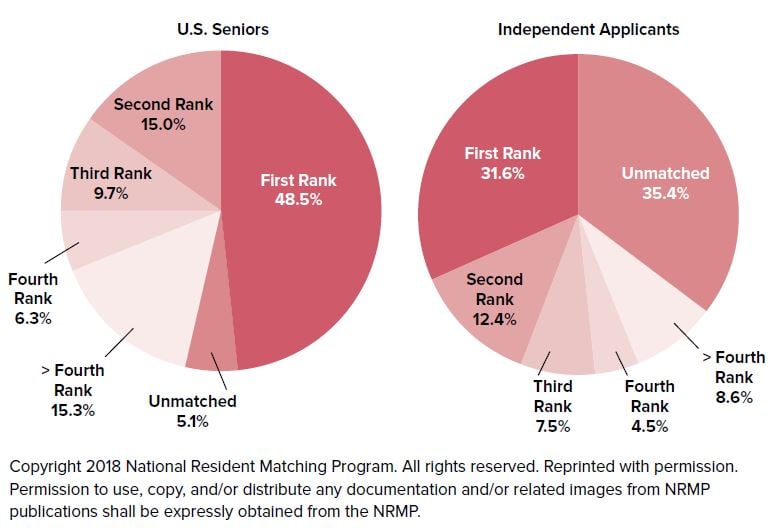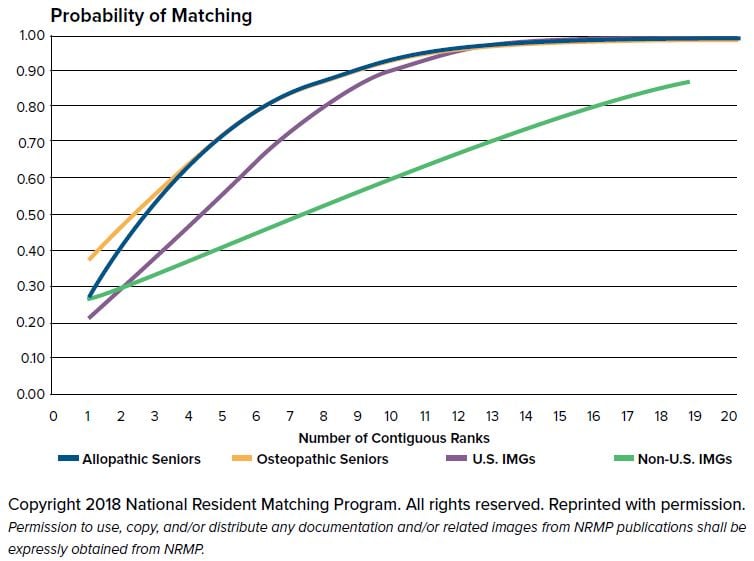Ch. 11 - Preparing and Submitting Your Rank List
Throughout interview season, you should be thinking about your rank list, comparing and contrasting programs as you go. Try to come up with a draft rank list and update it after each interview, placing the program you just visited in the list with your other programs and keeping notes about your thoughts on each program.
How Does the Match Work?
At the end of interview season, applicants submit a rank-order list of the programs at which they interviewed (and would want to match) from most to least preferred, and residency programs submit a rank-order list of applicants from most to least preferred. From there, a Nobel prize-winning algorithm goes to work to find “stable marriages” between applicants and programs. The “stable marriage problem” is well-known in the fields of mathematics, economics, and computer science and is considered solved when there is no pair of matches by which both a program and an applicant would be better off than they are currently matched.1
Picture this: You rank a program No. 1, and your No. 1 program has 12 spots available for interns. If that program ranks you in any of their top 12 positions, a match is made, and you will not be considered for matches at any other programs. Alternatively, you could also match at this program even if you were lower on their list; for example, let’s say they ranked you 20th, but 8 people ahead ranked different programs at the top of their lists and those other programs ranked the 8 people ahead of you high enough to create matches — you would still match at your top choice!
To see a live example of a simulated match between 5 applicants to 2 hospitals with 2 positions each, visit NRMP.org/matching-algorithm.
It is critical to understand that the NRMP algorithm favors your preferences as the applicant. You should rank programs in the order in which you would truly prefer to match. Do not try to “game” the system and rank programs based on where you think you fall on their lists. Similarly, expressions of interest from a program are not binding — interpret them with caution. Again, always rank programs in your order of preference. The first program you rank should be your top choice, even if you think it’s a reach. Conversely, do not rank a “reach” program first on your list just to see if you can match there if it’s not where you really want to end up. Overall, three-quarters of U.S. senior applicants will match at one of their top 3 choices. Unfortunately, across all specialties, 5% of U.S. seniors will not match (Chapter 12: What If I Don’t Match? explains what to do in that case).
FIGURE 11.1. Percent of Matches by Choice and Type of Applicant, 20182

Couples Match: To participate as a couple, both applicants must be entering the same match and pay a “couples fee.” The NRMP does not define who can couples match; you can couples match with a friend, spouse, partner, sibling, or anyone else who agrees to create a paired rank list with you. For more information, visit: NRMP.org/couples-match-videos.
How to Build Your List—What Matters to You?
There is no single way to build your rank list; the “right way” to build it is based on what is right for you. Many factors play a role in this.
Reflect on your professional and personal goals when prioritizing your list. Identify 3–5 things that matter most to you when comparing programs to rank. See Chapter 4 — Finding Your Fit: Learning the Landscape of EM for a list of factors that differentiate programs from one another. Some common elements to consider include:
- Length of training (3- vs 4-year program)
- Location of training
- Programs’ affiliated hospitals
- Residency rotation curriculum
- Flexibility of elective time
If you have already identified your interests in potential fellowship training, you may choose to weigh emergency medicine residency programs at sites that have that fellowship more heavily. The flexibility and amount of elective time in residency may also be important if you harbor fellowship goals, because it will facilitate dedicated scholarly time and research that will help you prepare for future fellowship applications.
Couples Match: Prepare your rank lists separately, then together. As a couple, discuss your priorities (same institution, same city, geographic distance, both partners matching at his/her top choice, etc). Are you willing to have one partner go unmatched? Avoid making a rank list in which one partner will definitely be unhappy.
How Many Programs Should I Rank?
Most faculty and deans agree that you should rank all of the programs at which you interviewed, with rare exceptions. Think carefully before choosing not to rank a program where you interviewed. On one hand, it is risky to include a program where you would not be happy training, because the match is binding for both applicants and programs. On the other hand, going unmatched puts you in a much more challenging position if you wish to pursue a career in EM. There are few to no positions that go unfilled in the EM match, so “scrambling” (now called SOAPing; see Chapter 12) into a position outside of the match is highly unlikely. Only leave a program off your rank list if you would rather train in something other than EM, or not match at all, than train there.
A program that you weren’t sure about on interview day might surprise you when you arrive to train there. All EM residency programs will lead you to the end goal of becoming a competent emergency physician. It will nearly always be better to be matched and move forward with your career path than to go unmatched with a gap year without structured clinical experience and patient care.
As mentioned in Chapter 9—Interview Season Logistics, with the exception of non-U.S. IMG applicants, ranking 11–12 programs will give you a > 95% chance of matching. The NRMP’s Interactive Charting Outcomes in the Match tool3 and its ranking guidelines4 can be very helpful as you determine how many programs you need to rank in order to match, and how to rank them based upon your individual competitiveness.
FIGURE 11.2. Probability of Matching to Preferrred Specialty by Number of Contiguous Ranks3

Military Match: MODS will allow you to rank 5 programs. Given the limited number of spots in the military match, you should rank ALL military programs where you interview.
At-Risk Candidates: Rank ALL programs where you interviewed. If you did not interview at enough programs to attain a high likelihood of matching, you have hopefully already developed a proactive backup plan with your academic advisor to apply to a second specialty or transitional internship.
How Do I Submit My Rank List?
Creating your NRMP rank list requires creating registering for the Match at NRMP.org prior to the registration deadline, usually in late November. This is a different registration process than ERAS. If you have trouble with registration, contact the NRMP help desk or ask your dean for assistance. Resources abound at NRMP.org, including tutorials and videos explaining every step of the process.
In mid-January, you can start to rank programs in the NRMP’s Registration, Ranking, and Results (R3) system. This website will use your credentials obtained when you registered in the fall. You should make sure you have the correct program identification numbers when you enter your rank list. Some schools/residencies have multiple program codes for different types of applicants. You will then enter the programs into the R3 system in your order of preference.
After you enter your rank preferences, you will need to certify your list. You must certify your list by the ranking deadline (February) to have it officially available for matching purposes. You will receive a confirmation email and see the status of your list change to “certified” when you have done this. You can re-rank and re-certify as many times as you want up until the NRMP’s Rank Order List certification deadline! Certify your list each time you make changes so you will always have an updated certified list in the system. The R3 system does not save old versions of your rank list.
Currently, you are allowed 20 ranked unique programs before you have to pay additional (nonrefundable) fees.
Help! Whom Should I Talk To?
Ask a friend, parent, significant other, or objective third party to help you talk through the programs in which you’re interested. If you’re bringing a significant other along during residency, be sure the cities you prioritize will have opportunities for them. You should also consult with your advisor to understand how different options may affect your career path.
Consider having a pretend Match Day!
- Place all programs at which you interviewed in a bowl.
- Have a friend pull a program out of the bowl and read the residency name out loud.
- How did you feel when that name was read?
- Ask your friend about their perception of your reaction to each program. If you are taking notes or using a spreadsheet, record your thoughts/response next to each program.
- If you are still unsure, “try on” a few programs and exercise your imagination. For one day, pretend you matched at Program A and see how you feel. Then the next day pretend you matched at Program B. This may help clarify your true preference.
Once you have certified your final rank list, your work is done — and the waiting begins.
The Bottom Line
- Start a draft of your rank list during the interview season, and keep notes as you go to help you as you finalize and certify your list.
- With rare exception, it is to your advantage to rank all programs where you interviewed.
- Understand that the match algorithm favors applicant preferences, so develop your rank list according to your true preference rather than trying to “game” the system based on what you think programs might do.




